(v13) Named color management
This page applies to Harlequin v13.1r0 and later; both Harlequin Core and Harlequin MultiRIP.
This section discusses the RIP's feature for replacing the alternate space and tint transform for individual spot colors. The color management of /DeviceN color spaces is discussed in (v13) DeviceN color spaces.
Named color management is enabled with a PostScript language fragment:
<</NamedColor [ /ncd_1 /ncd_2 ... ]>> setinterceptcolorspace
which contains a list of named color database (NCD) PostScript language resource names. These NCD resources are commonly present as disk files in the SW/NamedColor directory, but may also be defined by PostScript language code using the defineresource operator. Internally, the RIP will use the findresource operator to load the disk resident resources into memory when necessary. NCDs are PostScript language resources of the NamedColor category, which is a Harlequin extension.
There is no restriction on which, or how many, NCDs may be included in the list. It is straightforward to create custom made NCDs. Commonly, the list of NCDs is a subset of those shipped with the RIP in the SW/NamedColor directory:
<<
/NamedColor [
/PantoneU /PantoneV /PantonePLUSCoated /PantonePLUSUncoated
/PantoneCoated /PantoneUncoated /PantoneMatte
/PantoneGoeCoated /PantoneGoeUncoated ]
>> setinterceptcolorspaceFigure: Searching the list of named color resources illustrates the search for “ANTIQUE WHITE” through the IllustratorColors , PantoneCoated, and XRGB NCDs.
All of these NamedColor resources are shipped with the RIP and were chosen for the example only because they each have a different ColorSpace.
NamedColor databases for several generations of PANTONE colors are included with the Harlequin RIP and are shipped in the SW/NamedColor directory. Resource names are designed to be self-explanatory. Where data has been supplied by Pantone LLC using both M1 and M2 measurement modes the M1 data has the suffix _M1 on the resource file, and the resource with no suffix on its name is M2 data.
If a PostScript language job uses a color space array (CSA) such as:
[ /Separation (PANTONE 123 CVU) /DeviceCMYK {...} ]
the Harlequin named color management aima to replace both the alternate space (/DeviceCMYK in the example above), and the tint transform (the fourth element in the CSA which are usually quite lengthy), with those provided by an NCD. It asks each of the NCDs in turn whether they handle (PANTONE 123 CVU). The first NCD that handles it is used to provide the replacements; the remainder of the NCD list is not searched.
This method of using the first NCD in the list which contains a specific spot color name means that there is no value in including an NCD in the list if all names specified within it have also been specified in earlier NCDs in the list.
It also means that you should add a new NCD to the start of the list if you wish to override the replacement colors provided by NCDs that are already included.
The definition of NCD resources is in (v13) Named color database resources.
For many straightforward use cases, it is not necessary to write an NCD from scratch. Instead, it is convenient to make use of the HqnColorDatabase procset as described in (v13) HqnColorDatabase procset. This makes it simple to import named color data from spreadsheets and make use of standard methods. Details on other methods of constructing an NCD are also in the following sections.
It is common, but not necessary, to use NamedColorOrder resources (especially the /Intercept NamedColorOrder resource) when providing the list of NCDs; see (v13) Named color order.
While there is a lot of overlap in the color names used in the supplied PANTONE NCDs, the pre-defined Intercept NamedColorOrder does not include any NCD in which all spot names have been included in previous NCDs in the list.

Figure: Searching the list of named color resources
Following conversion to the alternate space of the NCD, the resulting colors may be further color managed. If the alternate space is a device space, this further color management may be controlled according to the rules of AllowColorManagement and ID; see (v13) Named color database resources. For examples of this control, see Merging component color pipelines and Illustrations of controlled merging of spots with color pipelines.
